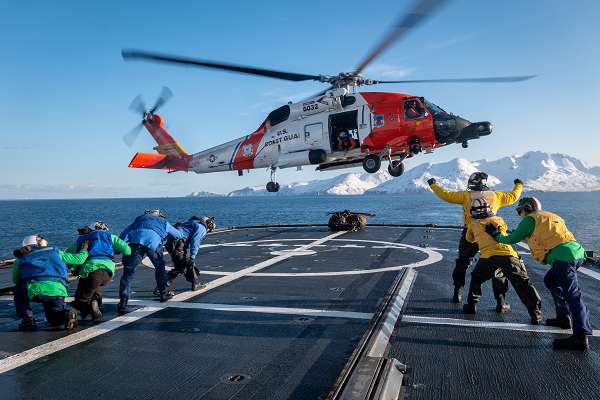
Kodiak, Alaska. (January 8, 2024): Yes, THAT Alex Haley. In this photo by Petty Officer 1st Class Jasen Newman, crew members assigned to the Coast Guard Cutter Alex Haley conduct in-flight helicopter refueling of a MH-60 Jayhawk helicopter while on patrol in the Bering Sea. The Cutter’s namesake is indeed the famous author of Roots: The Saga of an American Family that became a worldwide sensation and won him the 1977 Pulitzer Prize for Fiction. ABC adapted the book into a television miniseries that aired to a record-breaking audience of 130 million viewers. Haley served in the Coast Guard until his retirement in 1959 at the rank of Chief Petty Officer with an extensive list of decorations from his service in World War II and Korea.
The Cutter Alex Haley operates in one of the most dangerous oceans on earth. Its mission is to rescue ships at sea and enforce maritime law in America’s most northern regions. The Bering Sea is in the Northern Pacific Ocean which divides the two largest land masses on earth, the Americas and Eurasia. The narrowest point of the sea is the Bering Strait which is only fifty-three miles wide and whose strong currents and unpredictable depths make it particularly treacherous. The Bering is one of the coldest seas on earth with frigid temperatures often below freezing for most of the year. Its shallow depth, volatile weather, and extremely cold sea temperatures create waves that are shorter and pack more power than deep sea waves. Winter storms are frequent and severe, often coating the superstructures of ships with ice and generating wave heights that may exceed forty feet.
The Sikorsky MH-60T Jayhawk is the ideal aircraft for missions in conditions like these. The Jayhawk is a multi-mission, twin-engine, medium-range helicopter that is designed to perform difficult search and rescue missions in high seas. With a cruising speed of 162 mph and a range of over eight hundred miles, the Jayhawk is staffed by rescue swimmers and medical personnel who deliver lifesaving aid under the most extreme conditions. To accomplish these daring rescues, the Coast Guard must refuel its helicopters while they hover over the flight deck. This ability is critical when the Jayhawk is in an urgent medevac situation and needs to refuel quickly while remaining airborne.
Mariners in the great north can rest easy knowing the USS Alex Haley and her crew will be there in an emergency.


